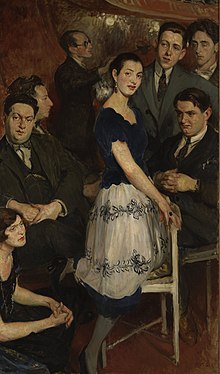Germaine Tailleferre

Germaine Tailleferre (born April 19, 1892 in Saint-Maur-des-Fossés , Val-de-Marne , † November 7, 1983 in Paris ; real name Germaine Taillefesse ) was a French composer and the only woman member of the group of composers Groupe des Six .
Life
Germaine Tailleferre was born near Paris as Germaine Taillefesse and changed her name as a young woman out of defiance of her father, who refused to support her musical education. She received her first piano lessons from her mother and already composed a few short pieces before moving to the Conservatory in Paris in 1904 . There she soon made the acquaintance of Darius Milhaud , Georges Auric and Arthur Honegger .
She won several first prizes in various disciplines at the Paris Conservatory. Tailleferre was the only woman to be a co-founder and member of the Groupe des Six, which influenced French musical life around 1920. Tailleferre was friends with Maurice Ravel , with whom she also studied instrumentation and who encouraged her to take part in the “ Prix de Rome ” competition . In 1925 she moved to New York with her husband, an American cartoonist, but returned to France in 1927. When the Second World War broke out, she left France again and came to the United States via Spain and Portugal. There she lived and worked in Philadelphia , Pennsylvania. After the war she returned to France.
Tailleferre created works of almost all musical genres, several operas , ballet music , concerts, piano and chamber music (including a string quartet , 1917/19), as well as music for film and television. Much of her work was not published until after her death. Stylistically, her music is attributed to Parisian neoclassicism . She proved to be open to new musical techniques. Due to an interest in the music of female composers emanating from the women's movement, Tailleferre has recently received increasing attention.
Works (selection)
- Quatuor à cordes in three movements: Modéré - Intermède - Final (1917/19)
- Jeux de plein air, for two pianos (1918)
- Fandango (1920) on YouTube
- Les mariés de la Tour Eiffel (1921, together with the other members of the Groupe des Six, but without Louis Durey )
- Sonata No. 1 for violin and piano (1922)
- Forlane pour flute et piano Editions Henry Lemoine, Paris
- Le Marchand d'oiseaux , ballet (1923)
- Piano Concerto No. 1 (1923) on YouTube
- Concertino pour harpe et orchester (1926)
- 6 chansons françaises, for voice and piano (1926)
- Il était un petit navire, Opéra comique (1951)
- Concerto des vaines paroles, for baritone and orchestra (1956)
- Le maître , chamber opera based on Eugène Ionesco (1961)
- Sonatina for violin and piano (1973)
- Le Concerto de la Fidélité (1981)
- Suite Burlesque for piano duet (1981) on YouTube
Web links
- Germaine Tailleferre in the Internet Movie Database (English)
- Video about Tailleferre (French)
Individual evidence
- ↑ One of 'Les Six' Still at Work . In: The New York Times . May 23, 1982, ISSN 0362-4331 ( nytimes.com [accessed July 7, 2019]).
| personal data | |
|---|---|
| SURNAME | Tailleferre, Germaine |
| ALTERNATIVE NAMES | Waistfeet, Germaine (real name) |
| BRIEF DESCRIPTION | French composer |
| DATE OF BIRTH | April 19, 1892 |
| PLACE OF BIRTH | Saint-Maur-des-Fossés |
| DATE OF DEATH | November 7, 1983 |
| Place of death | Paris |

